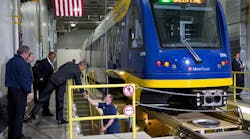President Obama laid out a proposal this week to spend some $302 billion over the next four years to in his words “repair essential highways and bridges, build new transit systems to help commuters spend less time in traffic, while construct smarter and more resilient transportation systems to better resist the impacts climate change like the flooding we’ve seen.”
Speaking at the new Union Depot transit hub in St. Paul, MN, Obama said much of the money for his infrastructure spending plan would come from “closing tax loopholes” and using that money create good jobs and good wages “rebuilding” America.
“Too many construction workers are looking for jobs when we have ports that need to get ready for modern supertankers, when we have 100,000 bridges old enough qualify for Medicare, and when we go through a winter like this when roads are wrecked and full of potholes all across the country,” the president said.
“Other countries not waiting to rebuild; China and Germany spend twice what we’re spending in order to build infrastructure because they know if they have the busiest and most efficient ports, businesses will go there,” he added. “They are out-building us to out-compete us. But I say the best roads, best airports, and best trains should be right here in America. At a time when companies are saying they plan to hire more people, we need to help make that decision easier and create jobs at the same time.”
Many industry groups are lining up to support President Obama’s proposal. "It is encouraging to see President Obama pushing for a long-term bill to fund desperately needed highway and transit investments,” noted Stephen Sandherr, CEO of the Associated General Contractors of America (AGCA), in a statement.
“We look forward to reviewing details about the measure, which recognizes the federal transportation funding shortfalls that threaten to curtail investments in highway and transit projects as early as this summer,” he added. “The president clearly understands that any new transportation bill must include new sources of revenue to meet the needs of our aging transportation system. We expect this proposal will stimulate the debate about the best way to fund the federal program.”
That “debate” is already getting underway in Congress, where Rep. Dave Camp (R-MI), chairman of the House of Representatives Ways and Means Committee, released draft tax reform legislation this week dubbed the “Tax Reform Act of 2014” that dedicates $126.5 billion to the Highway Trust Fund (HTF) to fully fund highway and infrastructure investment for eight years.
“This legislation does not reflect ideas solely advanced by Democrats or ideas solely advanced by Republicans, nor is it limited to the halls of Congress,” Camp said in a statement. “Instead, this is a comprehensive plan that reflects input and ideas championed by Congress, the Administration and, most importantly, the American people. In other words, it recognizes that everyone is a part of this effort and can benefit when we have a code that is simpler and fairer.”
Rep. Bill Shuster (R-PA), chairman of the Transportation and Infrastructure committee, endorsed Camp’s tax reform plan – especially highlighting its aim supplement the HTF’s dwindling user fee revenues – and offered a positive nod to President Obama’s proposals as well.
“This fiscally responsible provision would provide greater certainty for the HTF and the nation’s surface transportation infrastructure in the coming years,” Shuster said.
“The transportation committee continues to develop surface transportation legislation for action later this year, and this tax reform proposal could play a meaningful role,” he added. “Chairman Camp and President Obama have presented proposals that I hope will bring increased focus to the challenges facing the HTF and the importance of the federal role in our national transportation system.”
Gov. Bill Graves, president and CEO of the American Trucking Associations (ATA) trade group, also gave a thumbs up to the spirit, if not the details, fueling both proposals.
“It is heartening that both President Obama and Chairman Camp recognize the critical need for revenue to finance infrastructure improvements,” graves said in a statement. “While a sustainable source of long-term, funding would be preferable, given the apparent reluctance to embrace traditional, user-funded revenue streams, ATA is prepared to keep an open mind when looking at financing options for the HTF.”
While any agreement on how to come up with the desired amounts of transportation monies proposed by both Camp and President Obama still needs to be worked out, a variety of groups emphasized that the need for such outsized infrastructure funding is only growing.
Terry O’Sullivan, general president of the Laborers’ International Union of North America, pointed to data compiled by the annual infrastructure report issued by the American Society of Civil Engineers (ASCE) that gave America’s infrastructure a “D+” for surface transportation categories in 2013:
- Roads received a grade of D as compared to a grade of D- in 2009;
- Bridges received a grade of C+, up from a C in 2009;
- Transit received a D, showing no change from 2009; and
- Rail received a grade of C+, up from a C-, the greatest increase in the 2009 Report Card.
O’Sullivan added that the average bridge in the U.S. is 45 years old, dangerously close to the average 50-year lifespan, and that every dollar invested now in transportation infrastructure could save $14 late due to higher costs caused by further deterioration as well as save motorists over $324 a year on average spent on fuel wasted due to traffic congestion and on extra vehicle repairs due to poor road conditions.
Yet despite those travails, President Obama indicated in his speech that some sort of deal could be worked out. “We are seeing some glimmers of hope,” he emphasized. “Roads and bridges should not be a partisan issue [as] more Americans should have access to affordable and efficient transportation. This is not the end. This is the beginning; we’ve got a lot more rail to lay and a lot more roads to travel.”



